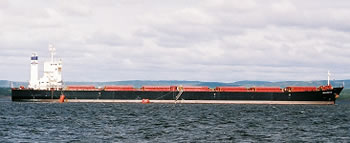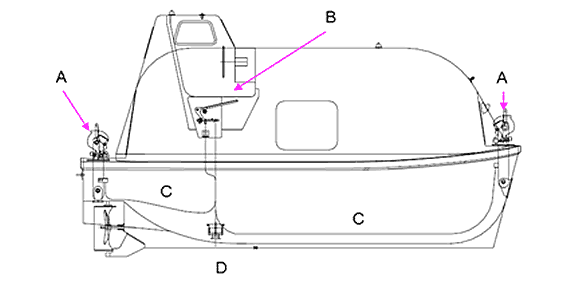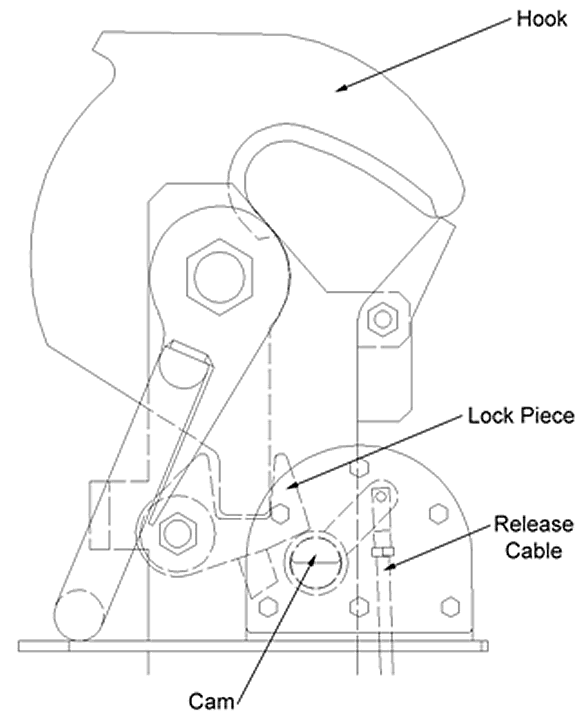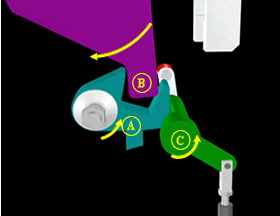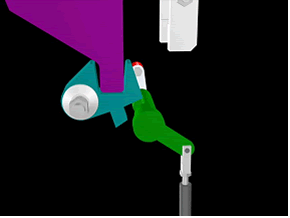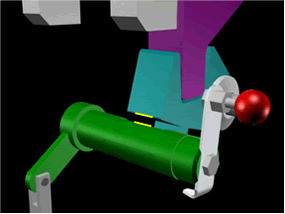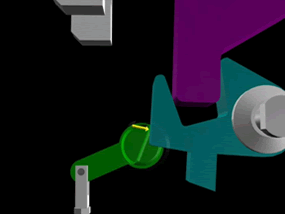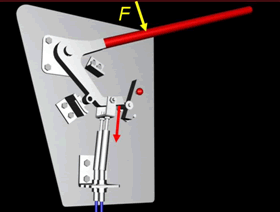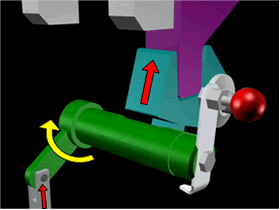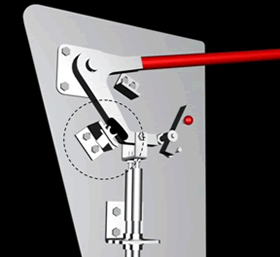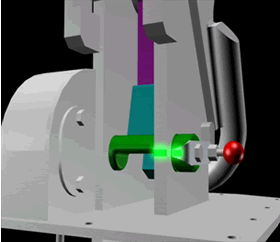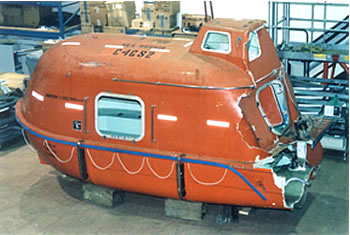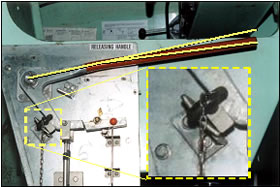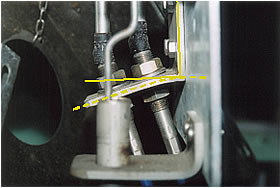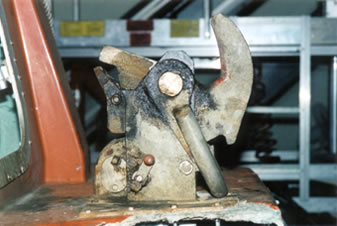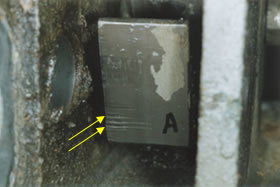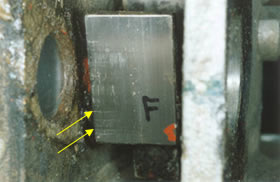Accidental release of lifeboat and loss of life
Bulk carrier Sea Urchin
Bay of Sept-Îles, Quebec
The Transportation Safety Board of Canada (TSB) investigated this occurrence for the purpose of advancing transportation safety. It is not the function of the Board to assign fault or determine civil or criminal liability. This report is not created for use in the context of legal, disciplinary or other proceedings. See Ownership and use of content. Masculine pronouns and position titles may be used to signify all genders to comply with the Canadian Transportation Accident Investigation and Safety Board Act (S.C. 1989, c. 3).
Summary
On the morning of 22 May 2006, while at anchor in the Bay of Sept-Îles, an abandon-ship drill was carried out on board the bulk carrier Sea Urchin. At 1150 eastern daylight time, during the recovery of the starboard lifeboat, the aft hook-release gear mechanism opened. The forward mechanism, unable to take the full load, also opened. The lifeboat then fell 11 m, stern first, into the sea, fatally injuring one of the five crew members on board.
Factual information
Particulars of the vessels
| Name | Sea Urchin | Standard Lifeboat |
|---|---|---|
| Official / IMO number | 27972-01/9244233 | - |
| Port of registry | Limassol, Cyprus | - |
| Flag | Cyprus | - |
| Type | Bulk carrier | SZ-53BR |
| Gross tonnage | 38 938 | - |
| Length overallFootnote 1 | 224.89 m | 5.3 m |
| Draught | Forward: 11.75 m Aft: 12.45 m |
- |
| Built | 2001, Imari Shipyard, Japan | Shigi Shipbuilding Co. Ltd, Osaka, Japan |
| Propulsion | Diesel (Burmeister & Wain 7S50MC) | Diesel (Yanmar 3JH25A) |
| Cargo | 59 836 tonnes of alumina in bulk | - |
| Crew | 23 | 25 (maximum capacity) or 1875 kg |
| Registered owner / manager | Keel Marine Co. Ltd / Blossom Maritime Corporation, Piraeus, Greece | - |
Description of the vessel
The Sea Urchin is a Panamax gearless bulk carrier with seven cargo holds. The accommodation, bridge, and engine room are located aft (see Photo 1). The vessel is equipped with two identical lifeboats, located outboard of the accommodation, one on each side.
Description of the lifeboats
There are two davit-launched gravity-type enclosed lifeboats (model SZ-53BR). The lifeboats are self-propelled, self-righting, and fitted with hook-release gear mechanisms. They were manufactured in April 2001 in Osaka, Japan (see Photo 2).
This lifeboat type was approved by the vessel's classification society, Nippon Kaiji Kyokai (Class NK), under the approval number N-478.
This design uses a remote-launching system intended to allow 25 persons to board the lifeboat before leaving the vessel.
History of the voyage
The Sea Urchin departed Bunbury, Australia, on 15 April 2006, with a cargo of alumina for Aluminerie Alouette at Sept-Îles, Quebec. The vessel arrived at Sept-Îles on 22 May 2006 and anchored in the bay at 0800,Footnote 2 2.5 nautical miles north of the Aluminerie Alouette plant at the approximate latitude and longitude of 50°10′02″ N, 066°29′00″ W (see Appendix A).
That same day, the chief officer (C/O) carried out a lifeboat drill to familiarize and train crew members with the lifeboats. For the majority of participating crew members, this was their first practical abandon-ship drill on that vessel since joining.
At approximately 1020, the C/O requested that the second officer (2/O), third officer (3/O), as well as the boatswain, two ordinary seamen (OS), three able seamen (AB), and the electrician, muster near the port lifeboat for a pre-drill training session. Once crew members donned their lifejackets, they boarded the lifeboat. While the C/O stood outside on deck, he gave step-by-step instructions on how to release the painter and activate the hook-release gear mechanism. After disembarking, crew members were asked to confirm if they understood the operation; they responded in the affirmative.
Two drills were to be carried out subsequently. Five crew members, including the 2/O, and the 3/O - who was in charge of the port lifeboat - re-boarded for the first drill. Once the five crew members had fastened their seat belts, the C/O ordered the lifeboat to be lowered. When the lifeboat entered the water, the C/O ordered the hooks released and thereafter for the hook-release gear to be reset. To this end, two crew members inside the craft pulled the hooks inward to the reset position; another crew member pushed the release handle down in place, the safety pin was inserted, and the davit fall long links set in the hooks. When all aboard returned to their seats and were belted, the C/O ordered the lifeboat raised. The hoisting of the lifeboat was uneventful. Afterward, the crew disembarked and proceeded to the starboard lifeboat for the second drill.
The 2/O, in charge of the starboard lifeboat, felt uncomfortable as it was his first time on the Sea Urchin and asked the 3/O to join him. With them were two ABs and an OS. The C/O and other crew members remained on deck. As with the first drill, the starboard lifeboat was lowered and, when it was afloat, the C/O ordered the hooks released. Once done, he ordered the hook-release gear to be reset. The 3/O reportedly had difficulty inserting the safety pin, but accomplished this with the help of another crew member. Eventually, he reported that everything was in place with the davit fall long links set in the hooks; the C/O subsequently ordered the lifeboat raised.
At 1150, as the davit arms started to rock back in, the aft hook released. Subsequently, the forward hook released and the lifeboat fell 11 m, hitting the water stern first at an approximate angle of 70°. The craft then capsized on its port side and began taking on water.
The master was immediately informed, and the general alarm sounded. At 1153, the master called the Marine Communications and Traffic Services (MCTS) centre to request assistance.
The lifeboat ruptured upon hitting the water, creating an opening through which two crew members exited into the sea. One was subsequently rescued using a life ring and a rope ladder, and the other boarded the port lifeboat after it was lowered. Two other crew members were able to exit through the lifeboat's forward hatch and re-board the Sea Urchin.
A head count, however, determined that the 2/O was missing, and the master informed the MCTS centre. In response, at 1226, an MCTS officer radioed a Mayday Relay, requesting assistance from nearby vessels.
Sea Urchin crew members raised the forward end of the lifeboat using the provision crane. When the port access door surfaced, the body of the 2/O could be seen inside. Resuscitation efforts were attempted but failed.
Launching and recovery of lifeboat
Launch procedure
Launch can be initiated from inside the lifeboat - by pulling down the control wire linked to the davits' winch brake release mechanism - or by manually operating the brake from the vessel's boat deck.
Recovery procedure
Once the davit fall long links are set in the hooks, the lifeboat is raised and, when contact is made between the floating block and the davit arms, the lifeboat is swung inward into its stowage position.
Hook-release gear mechanism
There are a large number of often complex designs for release gear. The hook-release gear mechanism used in this occurrence, type SRS-37, is an on-load/off-load system. As shown in Figure 1, it is composed of forward and aft hooks (A), a release handle (B), and release cables (C). A hydrostatic interlock unit (D) prevents the accidental release of the hooks when the lifeboat is not in the water.
The hook assembly is composed of three main components: the hook, the lock piece, and the cam (see Figure 2). For simultaneous operation of the hooks, the release handle in way of the steering station is used. The release cables link the release handle to the cam lever of both hooks.
Resetting the release gear mechanism involves resetting the hooks and locking the mechanism Overall, this two-step task requires three people: one person at the steering station, and two other persons - that is, one at each hook.
Step 1: Resetting the hooks (Figures 3 to 6)
The hook is pulled inward to adopt an upright position ready for hoisting. Note how the hook tail (B) fits into the notch of the lock piece (A), exerting a rotating force that lifts the lock piece (see Figure 3) and allows for the full rotation of the cam (C) underneath (in step 2). The design requires the user to apply a fair amount of force on the hook to lift the lock piece into final position (see Figure 4).
If the reset has been done properly, clearance (yellow lines) is visible between the cam and lock piece (see Figure 5). Note that this clearance must be maintained using constant pressure on the hook to keep the lock piece in place. If this clearance is not maintained, the lock piece will pivot back down and interfere with the cam, preventing the resetting of the cam into its final position (see Figure 6).
Step 2: Locking the mechanism (Figures 7 to 10)
The second step requires pushing the release handle down (yellow arrow, F), thereby moving the release cables in the direction of the red arrow (see Figure 7); the release cable will in turn push the lever, causing the cam to rotate (see Figure 8). Note that, if the lock piece has pivoted down and interferes with the cam, the release handle will either not move or will only move following the exertion of an atypical amount of force. Moreover, if an undue amount of force is applied on the release handle, this force can cause deformation of the cable-attachment bracket and/or the release handle.
Once the release handle has been pushed down to its final position, the holes in the release handle and the safety bracket align, allowing for the insertion of the safety pin. The safety pin is then rotated to its locking position (see Figure 9).
Note: If the operation is carried out as designed, in the final reset position, the cam lever will be horizontal and the green reference marks on the cam lever assembly and the bracket will be aligned (see Figure 10).
Lifeboat inspection
Pre-occurrence
At the end of March 2006, the vessel called at Hyundai Vinashin Shipyard in Khanh Hoa, Vietnam, for a Special Class survey. This included a lifesaving-appliance survey, which in turn featured an overhaul, inspection, and test of the lifeboat's hook-release mechanism as well as an examination of the davits and a dynamic testing of the winch brake. These tests and the examination were all deemed satisfactory. At the time of the survey, the fall wires were replaced.
Post-occurrence
A post-occurrence examination of the port lifeboat revealed that its hook-release gear mechanism had been improperly reset during the drill on the day of the occurrence.
The starboard lifeboat was transported to the TSB Engineering Laboratory for examination and testing (see Photo 3).
Training
The Sea Urchin had a crew of 23, none of whom were familiar with the type of hook-release gear mechanism on board the lifeboats - with the exception of the C/O, who had familiarized himself with the documentation two months before the occurrence.
Onboard records indicate that crew members carried out an abandon-ship drill on 31 March 2006, before departing the shipyard. Accompanying comments refer to the exercise as "fair, not quite satisfactory." There was no written confirmation that lifeboats were lowered at that time. Two additional abandon-ship drills were conducted at sea, one on 05 April 2006 and the other on 06 May 2006; both were described as "satisfactory," although neither instance involved lowering the lifeboats. In both cases, crews took their place inside their designated lifeboat while the C/O explained the operation of the release gear. There was neither a formal evaluation of the crew's knowledge of the release gear mechanism nor any hands-on system usage - crew members were nonetheless told to become familiar with the system. At the end of those training sessions, crew members were asked if they understood; they responded in the affirmative.
Training material
Copies of the instruction manual for the type SRS-37 hook-release gear mechanism, as well as the lifeboat's operating and maintenance manual, were available in the crew's mess room.Footnote 3 Following the 05 April 2006 abandon-ship drill, the C/O requested that these be read by the crew.
The instruction manual for the hook-release gear mechanism features coloured pictograms with Japanese text, as well as a translation in English, which was the vessel's working language. Coloured pictograms and warnings were also posted inside the lifeboats.
According to the manual, the hook is reset when a crew member pulls it inward. The manual mentions the need to check for clearance and the alignment of the green reference marks, but there is no mention of the need to maintain constant pressure on the hook until the cam is fully rotated.
Similarly equipped vessels
According to the manufacturer, approximately 500 lifeboats were fitted with the type SRS-37 release gear mechanism. However, as its products are often sold through third parties, the manufacturer has stated that there were difficulties in contacting/tracing current owners.
Additionally, type SRS-37 has been out of production for several years; a new production design no longer requires crew members to manipulate the hook during reset.
Analysis
Hook-release gear mechanism
Before the recovery of the starboard lifeboat, the crew had difficulties lowering the release handle to its final position. Additional force by two crew members was applied in order to lower the release handle to a position where the safety pin could be inserted. In this instance, the release handle and the cable attachment bracket were found deformed and the safety pin inserted, but not rotated into its locked position (see Photo 4 and Photo 5).
When the release handle is lowered with the lock piece in an intermediate position, the lock piece interferes with the cam rotation. Any additional force applied on the release handle will translate into the release cable attachment bracket being deformed. The greater the deformation, the closer the release handle will be to its reset (final) position. With each subsequent deformation, and closer to final positioning of the reset handle, it becomes more likely that, given the short distance needed to achieve the goal of inserting the safety pin, an operator will attempt to force the system.
During the post-occurrence salvage, as the starboard lifeboat was being raised from the water, the cam lever on the aft hook assembly was observed as not being in the horizontal reset position (see Photo 6 and Photo 7); hence, the hooks were not locked in place before the recovery.
Although the release handle was locked by the safety pin, the cams (both fore and aft) were not fully rotated under their respective lock pieces. The interference resulting from the incorrect re-setting of the hooks, combined with the force required to insert the safety pin, accounted for the subsequent residual compression force in the release cables/cam lever assembly.Footnote 4
This in turn generated sufficient friction between the cam edge and the lock piece to hold the hook in place and bear the load of the lifeboat. While the lifeboat was being hoisted, it was in a quasi-static state - at least until the floating blocks reached the davit arms, at which point the shock resulting from impact overcame the friction that held the aft hook in place. This released the davit fall long link. As the lifeboat's aft end began to fall, the load was transferred to the improperly reset forward hook, which could not absorb the additional load and released, allowing the lifeboat to fall.
Even though the mechanism is set improperly, an operator can be deceived that the mechanism is operating safely by lowering the release handle into position and being able to insert the safety pin. This false sense of security is enhanced by the hooks remaining in vertical position, capable of holding the lifeboat during the hoisting operation.
At the International Maritime Organization (IMO) Maritime Safety Committee (MSC) 82nd session held in November 2006, a proposal was drafted regarding the prevention of the accidental release of lifeboats during recovery.Footnote 5
... 3 to prevent an accidental release during recovery of the boat, unless the hook is completely reset, either the hook shall not be able to support any load, or the handle or safety pins shall not be able to be returned to the reset (closed) position without excessive force. Additional danger signs shall be posted at each hook station to alert crew members to the proper method of resetting;
The large number of often complex designs, combined with the fact that crew members rarely return to the same vessel, creates a lack of familiarity with an essential piece of lifesaving equipment, thereby continuing to put seafarers at risk.
History of improper resetting
The interference or lack of clearance can be seen in Photo 8 and Photo 9. These photos show multiple indentations where the cam previously interfered with the lock piece of the starboard lifeboat.
The multiple indentations on the lock piece, caused by contact with the cam edge, suggest that this scenario had taken place before- a repeated pattern of improper resetting that put the safety of crew and equipment at risk.
Crew training and familiarization
Training material
Before this occurrence, training consisted of a brief, on-site system familiarization and a request that crew members read the instruction manuals. Reportedly, they did read the manuals and acknowledged having understood the mechanism. However, physical evidence as found on the mechanism pieces suggests that this was not the case and hence the onboard training did not meet its objectives. There was no formal knowledge evaluation after the drills, nor was there any hands-on training. The next opportunity for the crew to interact with the mechanism was not until the day of the occurrence.
The successful resetting of the hooks is paramount to properly resetting the release gear mechanism, with the essential point being an understanding of the interaction between the hook and the lock piece. Although the SRS-37 instruction manual addresses the issue of clearance and interference between the lock piece and the rotating cam, the manual does not draw the user's attention to why the lock piece can pivot back down, nor does the manual highlight the need to maintain constant pressure on the hook until the cam is fully rotated.
The IMO has previously recognized that user-friendly manuals for lifeboat systems - especially for release gear systems - are important to help preventing casualties.Footnote 6 The Marine Accident Investigation Branch (MAIB) of the United Kingdom also recognizes the need to explain the reasoning behind a given procedure:
For training material to be effective ... knowing why things are done... will do much to ensure [a] trainee understands the procedures and will remember them when under pressure. Inspection of many training manuals reveals they do not extend this far.Footnote 7
Content could, for example, include "an explanation of the structure and working principle of the major parts,"Footnote 8 the relationship between diagrams and text, and a comprehensive step-by-step approach - all of which contribute to a better understanding.
Without full comprehension of the reasons for a given procedure, there exists a risk that crews may not place adequate emphasis on instruction manuals, particularly when very different release mechanisms can look very similar.
Hands-on training
Subsequent to joining the vessel, crew members were told to read the manual for the lifeboat, which includes the hook-release gear mechanism. There was no confirmation or evaluation that the material had been understood and that crew members were proficient with its use.
Release gear mechanisms come in a variety of designs. It is therefore crucial that crews be proficient with the use of the onboard equipment. To be effective, the knowledge gained from any training manual must be applied to an actual hands-on situation - preferably a stress-free environment before actually conducting a drill - which allows for safe trial and error.
This process transforms theoretical knowledge into practical understanding and skill. It is also recognized that training enhanced with models or replicas improves knowledge transfer. Failure to confirm that theoretical knowledge has been safely transformed into practical understanding and skill will continue to put users of release gear mechanisms at risk.
Findings
Findings as to causes and contributing factors
- The aft release mechanism opened with the impact of the floating blocks on the davit arms. The load was then transferred to the forward hook, which, due to improper resetting, released and caused the lifeboat to fall.
- Because the hooks were not held in their proper position during the reset of the release mechanism, the hooks were improperly reset.
- Residual compressive force in the release cable allowed the lock piece to be held in place by friction alone, making hoisting of the lifeboat possible.
- The deformation of the release cable attachment enabled the release handle to be secured in the reset position even though the hook-release mechanism was not properly reset.
- The combination of reading the instruction manual and a pre-drill training session was insufficient to ensure that crew members fully understood how to reset the hook-release mechanism.
Findings as to risk
- Although the instruction manual conformed to the International Maritime Organization format, its contents were less than adequate for a complete and thorough understanding.
- Some release gear mechanisms can appear to be properly secured even though they are not - creating a false sense of security that continues to place the lives of crew members at risk.
- Failure to ensure that theoretical knowledge concerning lifesaving equipment including release gear mechanisms has been safely transformed into practical understanding will continue to put seafarers at risk.
Safety action
Safety action taken
Transportation Safety Board
On 27 October 2006, the TSB made a presentation to the manufacturer, the classification society, and representatives from the vessel's Protection and Indemnity Club (P & I) regarding the identified safety deficiencies. As part of the presentation, animations were created of both a proper and improper resetting of the release mechanism. On 30 November 2006, the TSB issued Marine Safety Advisory (MSA) 11/06 to Transport Canada (TC), to request that the Paris and Tokyo Memorandum of Understanding (MOU) secretariats be informed that all vessels equipped with the type SRS-37 release gear mechanisms should be inspected, and that the ability of each ship's crew to safely operate the release mechanism be verified accordingly. This MSA was issued because it was felt that the manufacturer might not be in a position to ensure that all affected vessels were made aware of the design and operation inadequacies of this release gear mechanism.
International Maritime Organization
The International Maritime Organization (IMO) issued the following documentation related to lifeboat release mechanisms:
- MSC.1/Circ.1205;
- MSC.1/Circ. 1206; and
- Resolution MSC.218 (82) (see Appendix C), adopted 08 December 2006, Adoption of Amendments to the International Life-Saving Appliance (LSA) Code
Transport Canada
In response to the aforementioned MSA, TC advised the Paris and Tokyo MOU secretariats of this Port State Control issue and provided them with a copy of the TSB's MSA. The secretariats have sent a circular to their members with respect to the advisory notice, and the Paris MOU secretariats have posted the explanatory animation files on their Web sites for their members. Furthermore, TC has made its inspectors aware of the content of IMO Resolution MSC.218(82), relating to the general requirements for lifeboats.Footnote 9
Manufacturer
Shortly after the occurrence, the manufacturer took measures to review its instruction manual. After a review of the updated manual, the TSB determined that a risk remains that users might secure the release handle in the closed position without the hook being properly reset. Consequently, Marine Safety Information letter 08/06, concerning the updated instruction manual, was issued on 07 December 2006 to the manufacturer. The manufacturer replied that it considered the updated manual to be adequate.
Later, in March 2007, the manufacturer published a safety guidance specifically for the type SRS-37 release gear mechanism.Footnote 10
Ship management
The ship management company distributed to all ships under its control a safety instruction circular related to lifeboat operations.
The ship management company forwarded a copy of the internal investigation report to the ship's flag state indicating corrective and preventive measures.
Classification Society Nippon Kaiji Kyokai
In October 2006, Nippon Kaiji Kyokai (Class NK) issued Technical Information Bulletin TEC-0676Footnote 11 requiring that an overhaul of the unload release gear be carried out in the presence of a surveyor, and that this be done by a manufacturer's representative or person appropriately trained and certified by the manufacturer in accordance with MSC.1/Circ.1206.Footnote 12
On 13 April 2007, following the publication of the safety guidance by the manufacturer, Class NK issued Technical Information Bulletin TEC-0694 regarding the type SRS-37 release gear mechanism on the manufacturer's lifeboats.
This report concludes the Transportation Safety Board's investigation into this occurrence. Consequently, the Board authorized the release of this report on .
Appendices
Appendix A - Sketch of occurrence area
Appendix B - Reference materials
- International Maritime Organization (IMO), Maritime Safety Committee (MSC) Circular (Circ.) IMO MSC.1/Circ.1205 - Guideline for Developing Operation and Maintenance Manuals for Lifeboat Systems
- IMO MSC.1/Circ.1206 - Measures to Prevent Accidents with Lifeboats
- IMO Resolution MSC.218 (82), CHAPTER IV - SURVIVAL CRAFT
- Marine Accident Investigation Branch (MAIB), Safety Study 1/2001 - Review of Lifeboat and Launching Systems' Accidents
- Manufacturer SRS-37 Instruction Manual
- Classification Society Nippon Kaiji Kyokai Technical Information Bulletin TEC-0676
- Transportation Safety Board of Canada, Engineering Laboratory Report LP 042/2006 (available upon request)
Appendix C - Resolution MSC.218 (82)
CHAPTER IV - SURVIVAL CRAFT
4.4 General requirements for lifeboats
4.4.7.6
.3 to prevent an accidental release during recovery of the boat, unless the hook is completely reset, either the hook shall not be able to support any load, or the handle or safety pins shall not be able to be returned to the reset (closed) position without excessive force. Additional danger signs shall be posted at each hook station to alert crew members to the proper method of resetting;
.4 the release mechanism shall be so designed and installed that crew members from inside the lifeboat can clearly determine when the system is ready for lifting by:
.4.1 directly observing that the movable hook portion or the hook portion that locks the movable hook portion in place is properly and completely reset at each hook; or
.4.2 observing a non-adjustable indicator that confirms that the mechanism that locks the movable hook portion in place is properly and completely reset at each hook; or
.4.3 easily operating a mechanical indicator that confirms that the mechanism that locks the movable hook in place is properly and completely reset at each hook;
.5 clear operating instructions shall be provided with a suitably worded warning notice using colour coding, pictograms, and/or symbols as necessary for clarity. If colour coding is used, green shall indicate a properly reset hook and red shall indicate danger of improper or incorrect setting;
.6 the release control shall be clearly marked in a colour that contrasts with its surroundings.
